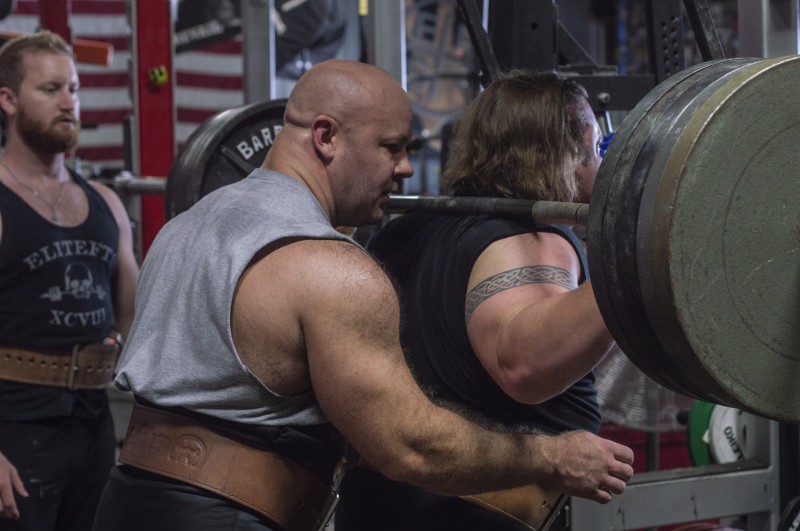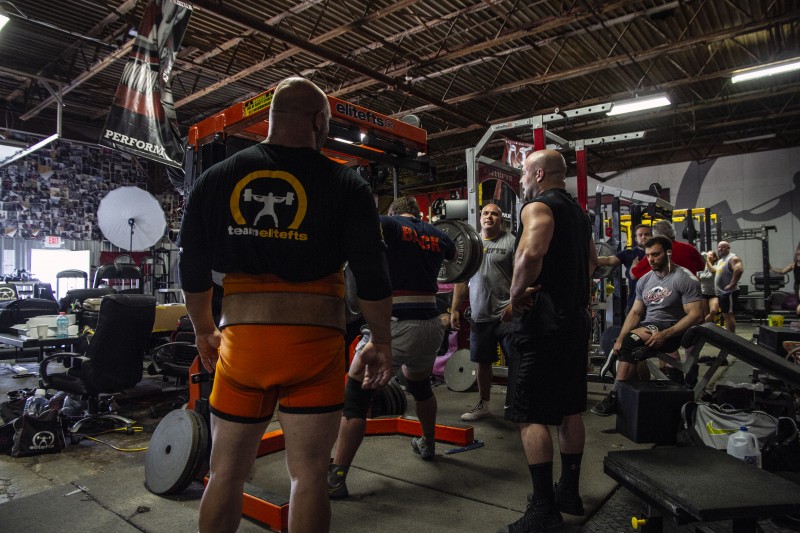
Conjugate or Westside style training has been the most productive style of training for me throughout my powerlifting career. Ironically, when I first started reading about conjugate I was seriously confused. I read a ton of articles and tried to understand it, but the more I read, the more confused I seemed to get. It was not until I finally attended a seminar with Dave Tate and elitefts that I got it. In fact, I believe when talking to Dave at the seminar, I asked him if it was really that simple. It seems to me people try to complicate it, but then again maybe it is just my natural gift of drawing things down to the simplest factors. Either way, it is the training style that gave me and my training partners the best results. To this day it frustrates me when people continue to complicate it and then say it does not work.
RECENT: Is Your Competition Outworking You?
There were many reasons I leaned towards Westside-style conjugate when I started powerlifting. One of my first attractions was dynamic effort training. I have a background in throwing, so being explosive was always something I strived for. The force equation (force = mass x acceleration) was also something I could not ignore. With the training I was doing, I kept getting this feeling that I was losing explosive power but was not sure how to incorporate it into the training I was doing. Another attraction I had was my hatred of programs that cycle strength, hypertrophy, and power through many waves. These programs work up to max effort strength and then back down, only to start all over again, and this never made a lot of sense to me. Conjugate is a continual progress of strength that may have some minor ups and downs but is always progressing. As I explored and learned more, I just kept realizing more things I like about the method, such as how it has its own way of auto-regulation if you're willing to realize and listen to it. It is also one of the easiest programs to focus on and train your weakest links. I have found it to be one of the most adaptable programs to meet each individual lifter's needs. There are definitely a few programs I have used with success in my lifting career and some that I will still recommend to lifters today, but conjugate is my favorite. It is the one I try to progress all my lifters to.
The conjugate method in the style I train has four major training sessions. These are the building blocks a lifter can start building his conjugate style from.
Session 1 — Max Effort Squat/Deadlift Day
Main Movement: One movement that trains the muscle groups used in the deadlift and the squat performed to a 100% maximum effort for one rep. Examples include good morning variations with different bars and accommodating resistance, deadlift, squat with different bar variations, box squat with different bar variations, rack pulls, etc.
Secondary Movement: One movement to work the posterior chain that is done with a heavy weight for three to four sets of eight to 10 reps. Examples include rack pulls, good mornings, Romanian deadlifts, Anderson squats, etc.
Glute Ham Raise: Three to four sets of eight to 10 reps.
Reverse Hypers: Three to four sets of eight to 10 reps.
The glute ham raise and reverse hypers have been staples in my conjugate training and I used them continually with ongoing great results. I know not everyone has access to them, so they can be replaced with lifts like pull-throughs (cable or band), Dimel deadlifts, Romanian deadlifts, straight leg deadlifts (making sure to push glutes back), back extensions, and similar movements. Glute ham raises can be performed without an actual GHR if you are creative with your setup and you can use bands to help assist with them.
Heavy Core or Mid-Section Work: Three to four sets of eight to as many reps as possible. Examples include pulldown abs, weighted declines, weighted sit-ups on the GHR, abdominal wheel, hanging leg lifts, medicine ball sit-ups, side bends with barbell, heavy dumbbell, or bands (weight or band only on one side), side planks while bracing, and landmines.
Session 2 — Max Effort Bench Press
Main Movement: One movement that trains the muscle groups used in the bench press performed to a one-rep max. Examples include bench press, board presses, floor presses, decline presses, suspended bench press, military press variations, etc.
Secondary Movements: One or two heavy triceps movements for three to four sets of eight to 10 reps. Examples includes JM presses and variations, high board narrow grip (shoulder width) presses, dumbbell roll backs, narrow grip floor presses, etc.
Military Press: Three to four sets of eight to 10 reps. These can be done barbell seated or standing or dumbbell seated or standing.
Row Variation: One heavy row variation for three to four sets of eight to 10 reps.
Upper Back: Two upper back movements for three to four sets of eight to 10 reps. Examples include face pulls (bands or cable), band pull-aparts, seated dumbbell cleans, YTWs (with blackburns), incline facepulls, incline YTWs, etc.
Heavy Core or Mid-Section Work: Three to four sets of eight to as many reps as possible.
Session 3 — Dynamic Effort (or Speed) Squat/Deadlift
Main Movement: Dynamic effort box squats with bands or chains for six to 12 sets of two reps.
Secondary Movement: Dynamic effort deadlifts for six to 12 sets of one rep.
The rest of the session is just like max effort session after the max effort exercise, including one supplemental exercise, GHR, reverse hyper, and midsection work.
Glute Ham Raise: Three to four sets of eight to 10 reps.
Reverse Hypers: Three to four sets of eight to 10 reps.
Heavy Core or Mid-Section Work: Three to four sets of eight to as many reps as possible.
Session 4 — Dynamic Effort Bench Press
Main Movement: Dynamic effort bench press with bands or chains for six to 12 sets of three reps.
The rest of the session is just like max effort after the max effort exercise.
Secondary Movements: One or two heavy triceps movements for three to four sets of eight to 10 reps. Examples includes JM presses and variations, high board narrow grip (shoulder width) presses, dumbbell roll backs, narrow grip floor presses, etc.
Military Press: Three to four sets of eight to 10 reps. These can be done barbell seated or standing or dumbbell seated or standing.
Row Variation: One heavy row variation for three to four sets of eight to 10 reps.
Upper Back: Two upper back movements for three to four sets of eight to 10 reps. Examples include face pulls (bands or cable), band pull-aparts, seated dumbbell cleans, YTWs (with blackburns), incline facepulls, incline YTWs, etc.
Heavy Core or Mid-Section Work: Three to four sets of eight to as many reps as possible.

That is a basic outline of the main four training sessions performed in the conjugate-style training I had so much success with. Lifters do need to remember that maximum effort is just that: maximum effort. You do not stop when it feels heavy or just because you're not sure you could do more. You go until it takes a full 100% of your strength to get the weight up. With beginning to intermediate lifters I will even go to failure because so many of them do not really even know what 100% effort is. They need to learn to struggle with weight and to train their CNS to handle maximum loads. On dynamic days there are lots of different percentages and phases (such as circa max) that lifters can use, but I have always preferred to keep this very simple, too. When I started I went through a wave of 53%, 55%, 57%, 59% and then started over again. After a while I just trained more by my speed and not much by the weight on the bar. Today when I work with clients, I start with around 50% and watch their speed to figure out their best working weight. Dynamic effort is about generating force and speed, which is way more important than the percentage of weight or weight on the bar.
RELATED: The 14-Day Program: An Interview with John Bott
So far this is all pretty simple, but there is the rub: you are going to have to think for yourself and figure out what your body really needs. I described the four main training sessions but I did not give what days you train these on. This is because it will be different for different lifters, and it is something you have to figure out on your own. You can do these four sessions in a range from seven days to two weeks. The most common way is to run it on seven days, but I find that many lifters, depending on their level, will overtrain and have to deload after three to four weeks. Over my career, I have done eight days to 14 days, all of which worked well during the time I used them but had to change as my strength changed. Who ever said everything in life should go off the seven-day workweek anyway?
You will also notice I did not put specific sets and reps but instead put a range. Some people may only need three sets, where another person may need four sets. Some lifters will do better doing 12 reps, where others will be better doing eight reps. Some lifters will be able to tax themselves with six sets of dynamic work and anything after that is just a waste of time. Other lifters will be better off doing 12 sets of dynamic work. I also left a lot of room for the lifter to pick different exercises. Part of conjugate is always confusing the body with a variety of exercises so that it cannot adapt to certain lifts. It is also important to pick lifts based on the individual and on their weaknesses too. Not every exercise works the same for each person, and some just simply work better for different individuals. It is up to the lifter to choose the most productive lifts for themselves. Training programs shouldn't be cookie cutter but instead individual in order to be the most productive.
I did not list exact max effort lifts to be performed either. This is because, again, the lifter is going to have to think here. Max effort lifts should be based on current weak areas and which max effort exercises will be best to strengthen those areas. For example, if the lifter has a mid-back weakness that is holding back his or her squat or deadlift then they should pick something like a cambered bar good morning to really work that area of their back. If a lifter is having issues with the lockout in their bench they should pick a max effort that focuses on that. A high board with much heavier weight would be a good choice here. Don’t just randomly pick your max effort work or do what you like.
Conjugate training has options when thinking in terms of auto-regulation too, but again it is something the lifter has to think about. As I mentioned, dynamic effort day is about the speed of the weight moved more than the amount of the weight on the bar. This is an area where you can auto-regulate yourself. If you are slow on a particular day but you still feel it is okay to train then you may want to drop your weight to maintain the proper speed. Conversely, if you feel awesome and can kick up the weight while maintaining good speed, you can do so. This is why I really only use percentage as guidelines. The same is similar with max effort days. Yes, most of the time we want to PR, but some days maximum effort is not what it is on other days. Some days you may not PR, but you still did 100% effort for that day and that is okay. The same goes for the training sessions as a whole. You do not have to do every single thing every day. This whole program is able to be auto-regulated, depending on your individual needs on that very day. This is simply an outline or better yet a list of guidelines to follow.
Conjugate style training is not complicated, but as you progress as a lifter it may become more complex. The complexities only come as you make it your own style based on what you need in order to reach the level you want to reach. Conjugate is simply a set of guidelines you can use to create the training program that will help you become the best lifter you can be. I truly believe that if any lifter keeps this in mind and is willing to think, they will achieve great success with this style of training. Along the way, I suspect they will learn a great deal of knowledge about strength training as well. In my next article, I will go into a little more depth about changes I made over the years.












Thank,
Chad
Thanks for the reply. Funny you mention doing the supplemental press first. I have done that in the past because I would sometimes cave to my teammates whining about it. They wanted there press (usually a military) to be stronger. For me the tricep is more important than the press on those days. We do sometimes do a shoulder press for max effort though.
Yes I have heard a lot of raw lifter bagging on conjugate but it works for raw too. Even when I competeted and trained gear my raw numbers where huge, I just never did raw meets and never regularly trained raw.
I always figured I was getting plenty of horizontal pressing with dynamic and max effort. I do more horizontal on recover day and accessory days though. Once I bench on max or dynamic I am pretty much toast in that plain. I am not totally against it though.
Thanks,
Chad
Sorry to take so long to reply. Speciality bar can be expensive and hard to find in commercial gyms. You do not have to use specialty bars but if you have access they are great. The biggest thing is to switch up exercises and that is easier to do with speciality because the same exercise is totally different with a different bar. So just be creative with your max effort exercises. Also bands really are not that expensive on EliteFTS and can make a standard bar feel very different for max effort work. Also well worth it for dynamic work. Even if you have to save for a couple months it is well worth it.
Accessory work is always standard strength training, 3 to 5 sets of 8 x 12 reps. For many years I made the mistake of doing all these to failure but that is wrong. Now I always try to stop with 2 reps in the tank. Still going as heavy as I can while doing that.
Chad
Sorry to take so long to reply, missed the email notification. On my max effort exercise I do go to a one rep max. I warm up gradually adding weight until I get one rep max. Some time I will do double or triples as well. Mostly one rep maxes though.
Chad